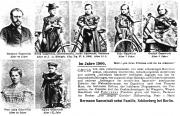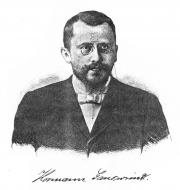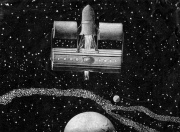Hermann Ganswindt
From The Space Library
Hermann Ganswindt is generally credited with being the first German engineer/inventor/scientist to propose a rocket propelled reaction vehicle for travelling to the moon and planets. His reaction propelled vehicle used a continuous stream of explosives to push its way through space. It is stated by Willy Ley in his history of rocketry that Ganswindt first postulated his ideas around 1891. He later met with Hermann Oberth and Willy Ley and briefly visited the set of Frau Im Mond in the 1920s.
Translation of text on attached postcard (left):
"Greetings from the much-vilified, persecuted by the dirty gutter press, unfair competitors, deadly authorities, and other "indirect murderers" - on the other hand, from the most important newspapers, impartial men, factual authorities and other "followers of the moral imperative" the recognized inventor of the world vehicle for the expedition to the planet Mars, the steerable balloon, the steerable aircraft, the pedal motor, the unicycle and the wire axis bearing for wagons, machines and bicycles. (Price list free and franco), author of the book "The Last Judgment" (self-published, price 1 Mark) Hermann Ganswindt and his family, Schöneberg near Berlin."
"In the vacuum of space of course you cannot catch the air with wings and glide down. So what must one do in order to still overcome gravity and rise up? Answer: - - you simply take with you a mass of air in the form of explosives, which also contains in itself the highest form of power! Thus can be construed a flying machine based on the reaction laws of exploding substances. I've invented this kind of flying machine rather than a flying machine with wings. Exact calculations have shown, however, that such a flying machine can only be driven with explosives in very economical terms of power consumption when it assumes a very high travel speed so that it is not suited for use here on earth, because the resistance of the air at such a tremendous speed becomes an obstacle. But the situation is different in airless space where there is no impediment to even the speed of a meteor or even that of a comet. And just such a speed is what we need for an expedition through the universe, because with the great distance of the heavenly bodies from each other a snail's pace would not get us to the goal. If for the purpose of the expedition one's eye catches, e.g., the planet Mars, because the moon would be uninhabitable, it is a very similar world to our earth, that is the nearest to us, but the distance amounts to the small sum of 8 million miles.
"How could you think it possible to cover such a distance in the vacuum of space alive, calls out the prejudiced indignantly! I answer just this: quite as easily as we are unexposed annually to the vacuum of space as we cover 125 million miles around the sun, without noticing it only with the exception of the transit times, by having the necessary air and everything else we need taken with our mother earth, for it moves with us through space with a speed of 4 miles per second.
"For an expedition of a few years away from the earth, we must of course also take air, heat, food and everything necessary that we have here on Earth, so that as we travel if we don't look out the window we notice nothing of it. Since the traveling speed is achieved by the fact that the already moving vehicle always has new exploding masses blowing up, and no obstacle to moving forward exists in a vacuum, the machine works more economically the faster you drive, the driving speed can after leaving the atmosphere even so increase that it could reach Mars or Venus in about 22 hours, when setting off with twice as large acceleration as that of gravity, you would slow down by the middle of the journey to some extent."
From "The Last Judgement - Inventions of Hermann Ganswindt" (1899)
The Last Judgement - Inventions of Hermann Ganswindt (1899) (German - Language) (20MB pdf



